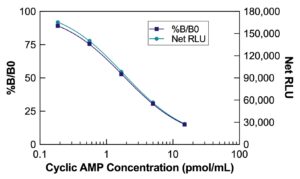Cyclic AMP Direct Chemiluminescent ELISA Kit
Personal Touch
Here to Help.
Ready to Ship
Most kits in stock.
Easy to Use
Simple protocols.
- Catalog Number K019-C
- Assay Type Competitive ELISA
- Sample Types Cell Lysates, Urine, Plasma, Saliva, Tissue, Tissue Culture Media
- Sensitivity 0.119 pmol/mL (Regular), 0.015 pmol/mL (Acetylated)
- Species Cyclic AMP is identical across species
- Assay Duration 2 Hours
- Samples/Plate 41 in Duplicate (Regular), 38 in Duplicate (Acetylated)
- Readout Chemiluminescent
Assay Principle:
The DetectX® Cyclic AMP Direct Chemiluminescent ELISA Kit offers a highly sensitive and efficient method for quantitatively measuring Cyclic AMP. The kit is compatible with various samples, including cell lysates, urine, plasma, saliva, tissue, and tissue culture media. This competitive ELISA has a run time of 2 hours and is multi-format, capable of detecting both acetylated and non-acetylated cAMP across different sample types. Read the complete kit insert for detailed instructions before running the assay. The kit includes a Cyclic AMP standard for establishing an accurate standard curve.
Protocol Summary:
- Introduce standards or diluted samples into the provided transparent microtiter plate coated with donkey anti-sheep IgG antibody.
- Add Cyclic AMP peroxidase conjugate and Cyclic AMP sheep antibody to initiate the immunological reaction.
- Incubate the mixture for 2 hours at room temperature with shaking. The reaction varies inversely with Cyclic AMP concentration in the sample.
- After incubation, wash away excess conjugate and add the chemiluminescent substrate. The substrate reacts with the bound conjugate to produce a measurable signal.
- Use a plate reader to detect the signal intensity and calculate Cyclic AMP concentration based on the standard curve.
Background:
Sutherland and Rall discovered Adenosine-3’, 5’-cyclic monophosphate, or cyclic AMP (cAMP), in 1957. It is an important secondary messenger and an essential intracellular regulator. cAMP plays a critical role in mediating the activity of various hormones, including epinephrine, glucagon, and ACTH. It is produced by the activation of adenylate cyclase, which is stimulated by hormones such as glucagon and adrenaline, and by G protein activation. The liver’s adenylate cyclase has a stronger response to glucagon, while muscle adenylate cyclase responds more robustly to adrenaline.
The enzyme phosphodiesterase catalyzes the decomposition of cAMP into AMP. Cyclic AMP’s broad role in cellular signaling and regulation is reflected in the Human Metabolome Database, which lists 166 metabolic enzymes that convert cAMP. This makes the DetectX® Cyclic AMP Direct Chemiluminescent ELISA Kit a valuable tool for researchers studying cellular signaling pathways, hormonal regulation, and metabolic processes.





